Imagine a direct, fully connected and protected bike route from Roosevelt and Green Lake all the way to downtown. The city is studying how to make it happen.
And not only could the project fix some consistently dangerous collision hot spots, but the project would also fill in the last major missing piece in a complete Lake Union bike loop. This is guaranteed to become a major commuting and tourism draw, revolutionizing non-motorized transportation in the city and opening up Eastlake businesses to visitors like never before.
But that’s not all. The bike lanes can also come side-by-side with significant transit efficiency improvements connecting some of the most densely populated neighborhoods to our state’s biggest and fastest-growing job center.
SDOT presented three concepts for improving surface transit service between Northgate and the city center (you can see more details in this PDF):
- RapidRide – The cheapest option, this would be like our existing RapidRide service. Better bus stops and buses, a signal priority system, consolidated stops and not much else. For the rest of this post, we will ignore this option because it does not include significant biking and walking safety improvements. Sharrows on Eastlake Ave? Immediate disqualification.
- Targeted Investment – Basically RapidRide+. This option includes that RapidRide stuff, but also makes some changes to roadway design, including queue jumps for buses and bus lanes in select locations to help get buses around the worst traffic jams. This option could also come with bike lanes. Peak-hour transit speeds would improve 38 percent north of Denny, but only 10 percent south of Denny.
- Full BRT – Significantly more expensive that the RapidRide+ option, a full BRT option would involve major remakes of the roadway in order to provide transit-only lanes for nearly the entire length of the route. Plans presented also include bike lanes for the entire length of the route. Peak-hour transit speeds would improve 200 percent north of Denny. But the biggest improvement comes between Denny and Downtown (on Stewart/Virginia): 900 percent improvement in transit speed.
I know what you’re thinking. “Why even continue writing? Obviously we want Full BRT and bike lanes the whole way!” Well, you’re right. But there’s more to report, so stick with me.
First, let’s remember why the safety improvements are so important on this corridor. Here’s a map of biking and walking collision hot spots. Circles only appear if at least four people were in collisions in just four years. So if you see a circle, it’s a major problem area:
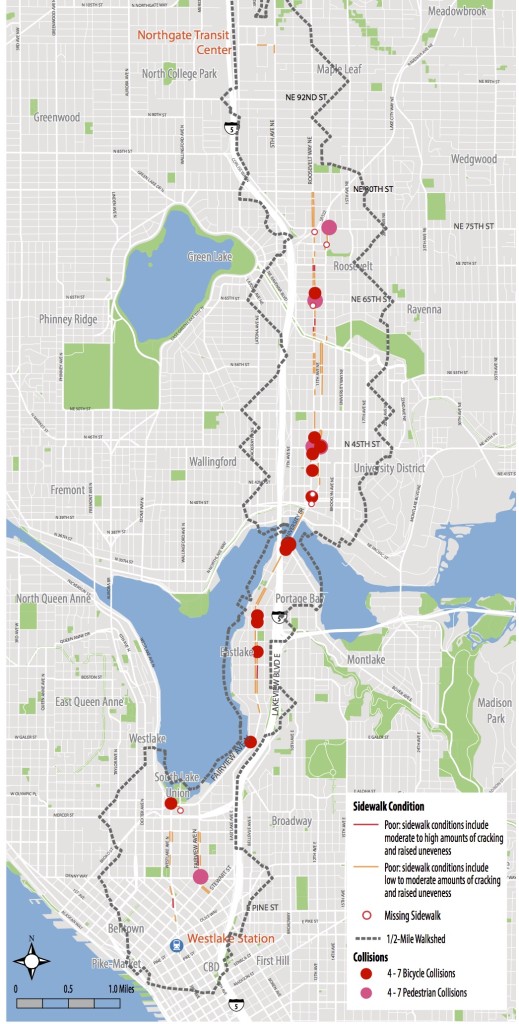 This is completely unacceptable. Dozens of people are getting hurt every year along nearly the entirety of the corridor. And anyone who bikes Roosevelt and Eastlake Ave regularly knows why. Cars are moving too fast, and there is simply not enough bike space to stay clear of pinch points and parked car doors. These streets need quality protected bike lanes. It’s the only way.
This is completely unacceptable. Dozens of people are getting hurt every year along nearly the entirety of the corridor. And anyone who bikes Roosevelt and Eastlake Ave regularly knows why. Cars are moving too fast, and there is simply not enough bike space to stay clear of pinch points and parked car doors. These streets need quality protected bike lanes. It’s the only way.
Also, remember that with the state’s 520 Trail extending from the Eastside to the Eastlake neighborhood in coming years, this corridor is set to become an even more important regional bike route than it already is.
Roosevelt/11th/12th
Roosevelt is relatively easy. The city already plans a protected bike lane as part of next year’s repaving project, and the design of that lane does not need to change significantly. To make it BRT, just make the travel lane next to the bike lane buses-only, and you’ve got it. Then copy the design to 11th/12th, which serves as the northbound complement to the southbound Roosevelt:
Eastlake Ave
Eastlake Ave is a bit more difficult, especially with transit-only lanes. Planners presented two concepts that don’t include exclusive lanes. Note that the first option requires moving the curb space, which is likely to be rather expensive:
We here at Seattle Bike Blog came up with our own variation on the city’s designs. Our option includes one-way bike lanes, which is preferred, but does not move the curb. It also allows for a more proper bike lane and barrier width.
And instead of having annoying off-peak-only parking on either side of the street, the city could preserve all-day parking or business loading zones on one side of the street where possible:
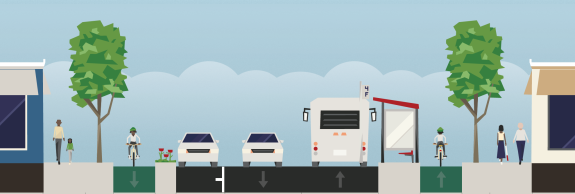 And to keep backed-up turning traffic out of the way of buses, the parking space could be used for dedicated turn lanes where needed:
And to keep backed-up turning traffic out of the way of buses, the parking space could be used for dedicated turn lanes where needed:
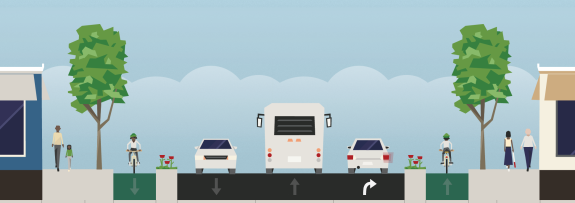 You can play around with the design options yourself using Streetmix (start with the existing conditions).
You can play around with the design options yourself using Streetmix (start with the existing conditions).
But if we go all-out on BRT, it’s gonna be a tight squeeze to fit everything on Eastlake. If we invest to move the curb, we could get enough space for skinny bike lanes, as outlined in this concept:
But these bike lanes would not meet the goal of all-ages-and-abilities bike routes as outlined in the Bike Master Plan. Perhaps by squishing the transit lanes a little and raising the bike lanes above street level, we could add some much-needed protection to the bike lanes.
Also concerning in the design, there does not seem to be space in this design for any bus stops unless buses merge with and stop in the general traffic lanes, which could be cool. We’re imaging something like this:
Or maybe the solution requires a little more creative thinking about how Eastlake Ave should really work. Because Eastlake Ave is the commercial center of the neighborhood, it should and easily could be a destination of its own.
Eastlake runs parallel to I-5, which should be the major route for through-traffic. How many of the cars on Eastlake Ave today are just passing through with no intention of ever stopping in the neighborhood? If those trips could be somehow encouraged to take I-5, Eastlake could be designed to focus on transit, biking and neighborhood access. After all, you only need transit lanes if there is backed up traffic in the way of buses.
And existing traffic levels on Eastlake Ave actually aren’t very high, clocking in between 14,000 and 15,000 vehicles per day (including bikes). That’s not many more vehicles per day than Dexter, which carries about 13,000 on its busier section in South Lake Union. So a complete street design could work well, especially if even a small number of through-trips can be encouraged to take I-5 instead.
How do we make this happen? That’s for the city’s planners to figure out. But it seems very achievable.
South Lake Union and Downtown
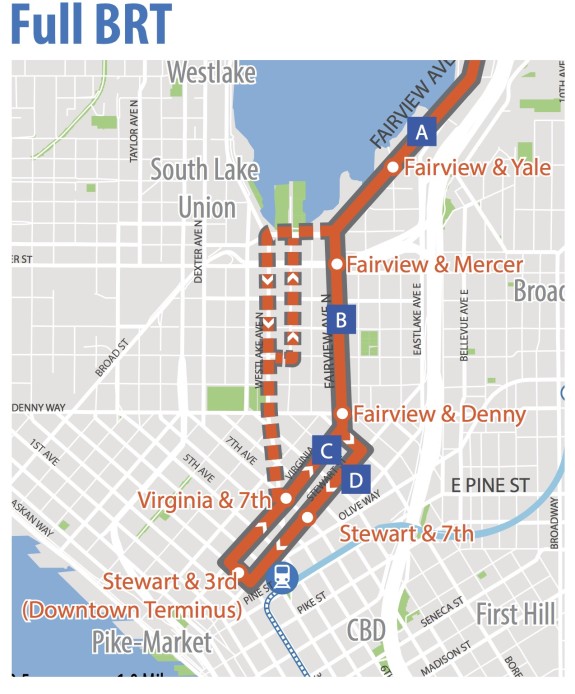
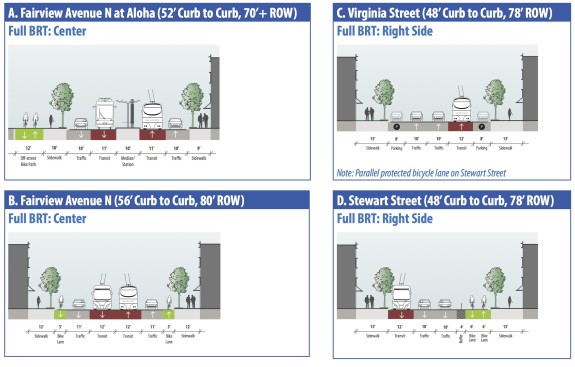
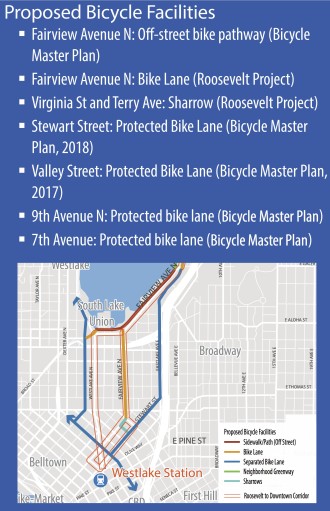 Now here is where those fully separated transit become very important. From Eastlake Ave to downtown is a major transit pinch point and a huge missing link in the regional bike network.
Now here is where those fully separated transit become very important. From Eastlake Ave to downtown is a major transit pinch point and a huge missing link in the regional bike network.
First interesting note: The section of Fairview Ave N between Eastlake and Lake Union Park (Section A) shows a two-way bike lane in the current parking area, much like the city’s plans for Westlake.
Without transit-only lanes, bike lanes fit easily on this stretch of street without touching the parking (we could build them tomorrow by extending the existing path over the soon-to-be-replaced bridge all the way to Lake Union Park). But with transit-only lanes, the parking area becomes a great option for the bikeway.
Also, the city is presenting an exciting concept for protected bike lanes on Fairview Ave N through South Lake Union (Section B). The concept image shows insufficient paint-only lanes, but with a little more space for a barrier and perhaps by raising the lanes above street level, they could be high-quality bike lanes. This is a very smart idea, and a major piece missing from the Bicycle Master Plan. These lanes would provide vital access to South Lake Union businesses and homes as well as providing the most direct route to the planned two-way bike lanes on Stewart St (Section D). From there, the lanes would be plugged into the planned Center City Bike Network.
The south section of this project could provide unprecedented transit efficiency and create a fully-protected and direct bike route into the city center. It is an absolute home run.
This whole project is a chance to remake a long and complicated corridor for biking and transit. Rather than piecemeal bits here or there, we could have it all in one go. Seattle almost never approaches transportation projects in this complete and connected way, and we couldn’t be more excited about it.
The details are very close to coming together. It’s going to take some creativity from the city’s street designers and some political guts to take on such a big project. And, of course, it’s going to take a lot more funding than what we have from Move Seattle to do it all. But the benefits are immense.
You can submit your feedback online by completing this survey.

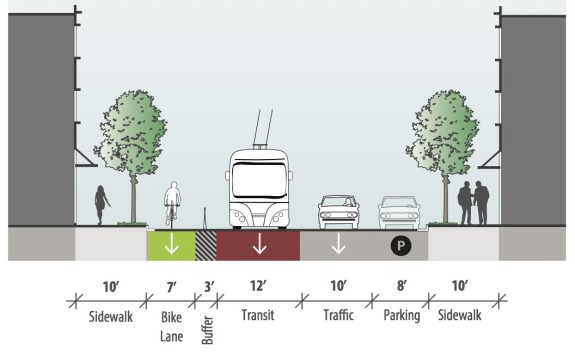
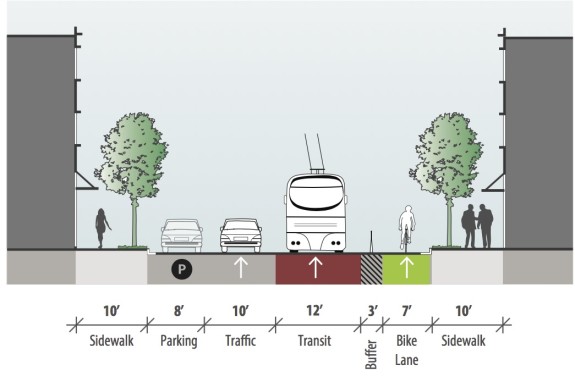
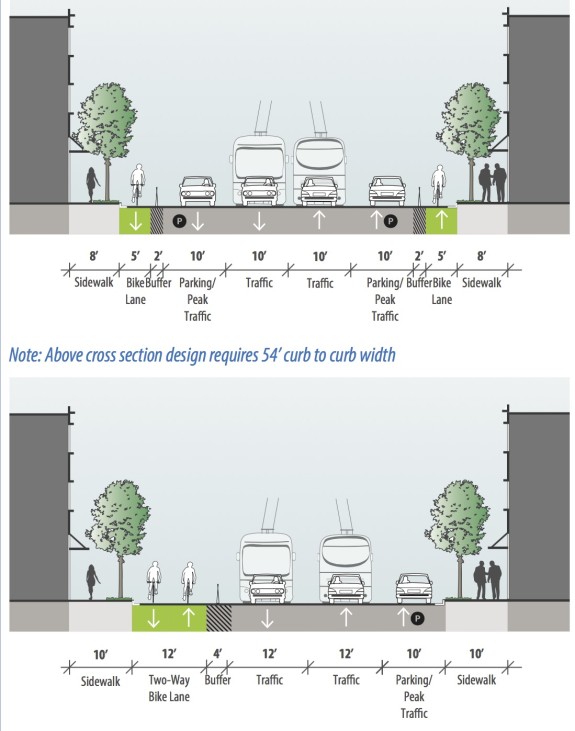
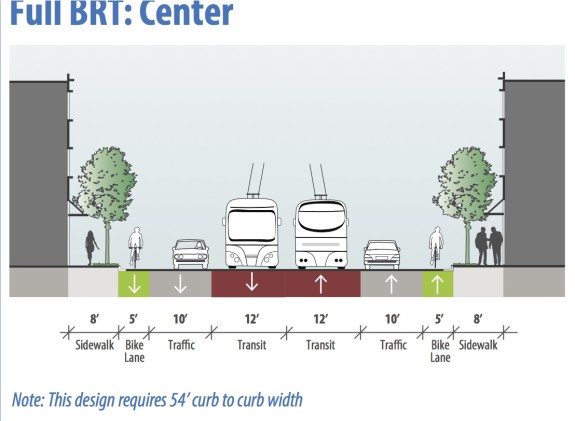
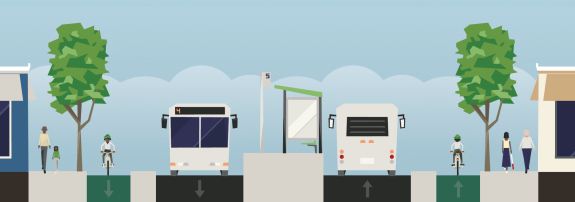







Comments
38 responses to “It’s time for a transportation revolution east of Lake Union”
I agree that a *connected system* is better than disconnected parts, BUT only if done WELL and SAFELY.
Having seen the mess they made of the first installment of this — the PBL on Roosevelt between NE 45th and the bridge — I’m *extremely* skeptical about this whole project.
There are lots of driveways and intersections on Eastlake that risk creating the same conflicts that bedevil Roosevelt. Will this be any better? Will they *fix* Roosevelt as part of this project?
No, it won’t be any better, because the most vocal voices advocating for bike infrastructure in Seattle are too willing to accept lipstick that actively makes things more dangerous for most cyclists, and are unwilling to accept that if a project can’t be done safely it shouldn’t be done at all.
I feel the need to stress providing a biking facility that all people can use. If a design is adopted where the bike lanes are completely separated from vehicle lanes, it forces all cyclists to use the bike lanes.
This will result in frustration and accidents for those who wish to go faster than 10-15 mph. Most streets don’t present this problem. Either, like Dexter N, it is easy for the cyclist to move into the traffic lane if needed. Or, like Broadway, take a different street. There are no good alternative high speed streets for Eastlake.
A better solution, in my mind, is design Eastlake to accommodate fast cyclists and encourage slow riders to use Fairview. This requires more new infrastructure on Fairview but might require less costs for Eastlake.
I have tried the PBL on 2nd Ave downtown several times. Over 10-15mph, downhill, I feel very unsafe in it. Too constricted and too vulnerable to drivers turning left on red (even though they aren’t supposed to). I think the same conditions would be true on Eastlake – you have to be prepared to stop at every driveway and intersection, making for stressful riding.
Again, I’m completely supportive of making a safer route for children and others who wish to be separated from traffic. Just not at the expense of the other quotient of riders.
I feel very strongly about this. Am I the only one?
http://www.thestranger.com/blogs/slog/2015/10/13/23004791/i-have-seen-the-future-bicycle-activists-dream-about
And counterpoint: http://www.aviewfromthecyclepath.com/2014/10/why-do-cyclists-fear-being-banned-from.html
Properly-built infrastructure gives you the best of both worlds: safety and speed.
While I haven’t been to been in Munich, I’ve spent time cycling in both Germany and the Netherlands. Despite German cycling infrastructure being incomparably ahead of Seattle’s, it still holds a sad little backseat to Dutch infrastructure. In the Netherlands it’s often faster and more direct to bike on the cycling infrastructure versus driving. That’s by design, just as it’s by design in the US that it’s usually faster and more direct to drive.
Looking around the 1:50 mark in this video, cycling speeds in Eindhoven on similar streets appear to be reasonably slow. https://www.youtube.com/watch?v=hgNfXbRwY14
I think the safety/speed tradeoff is worth it. Traffic jams cut your average speed no matter what your top speed is. Collisions even more.
I do agree about direct routes. From NE Seattle, biking along Roosevelt/Eastlake gets me to work in about 40 minutes. It’s maybe 15-20 more via the Burke-Gilman. Bombing down Eastlake or Roosevelt doesn’t cut anything significant off that time.
(I used to live on Capitol Hill, but have been primarily in Amsterdam for 3 years now.)
Dutch cycling infrastructure is enviable and every city in the world would do well to learn from it. But it should be noted that the fabric of the Netherlands, which is best understood as a large metro with some very sparse parts between neighborhoods, is not Seattle.
Riding here between cities is very fast, but in city centers the traffic (of other bikes and, alas, scooters) thickens and the pace is much slower. This is fine because the cities are compact.
I adore it all, but Peri’s concern for longer-distance riders is legitimate and not well served by the Dutch model.
Completely agree with you. I don’t use the 2nd Ave bike lane. Too slow, half the time it is blocked by construction, the other half of the time people turn illegally across it. I have to make a right hand turn at the bottom of the hill anyway so I just take the general lane. But now drivers give me crap for it because there is this sweet bike lane that I’m not using.
Yes. Just be clear, the 2nd Ave PBL is a great asset. You just can’t safely go over 10-15 mph in it.
On a different topic regarding BRT-only lanes: since the biggest benefit (and sorely needed) comes from adding BRT south of Denny, why not add BRT-only lanes just to that section and let the rest of the system be the Rapid Ride or “Rapid Ride +” approaches. It would give more flexibility to accommodating everyone – bikes, cars, parking, busses, deliveries.
It depends on what you mean by BRT. There are a few common parts to it, but let me mention three:
1) Off board payment. This means that the time a bus spends at a bus stop is minimal. This is the way that our light rail train works. You just get on or off.
2) Traffic signal treatments. This basically keeps the green light green longer if a bus is approaching (or switches it to green quicker if it is red).
3) Bus only lanes or something similar.
The first and second can make a huge difference. The third only matters when there is congestion. As you suggest, that may not be the case with Eastlake — traffic may flow adequately, which means that bus lanes aren’t needed. This is where a study makes sense. The city did a similar study for Madison, and decided that bus lanes weren’t needed to the east (closer to 23rd). The same may be true here — I don’t know. But given the cost of various options, I doubt the city will spend a huge amount of money if it leads to only a marginal speed increase.
One final note, which is that a speed increase anywhere helps the system, even if most of the riders don’t ride that section. For example, if delays are avoided on Eastlake, it makes a difference to riders taking this from downtown to South Lake Union, for a couple of reasons. First, the run becomes more reliable. Second, it is much cheaper to operate. Both of those allow for more frequency, which means less waiting, and thus a better experience for transit riders (and more popularity, which leads to a virtuous cycle of more fare box recovery and even more frequency).
I think it is worth pointing out what it would mean to have what SDOT calls the “Full BRT” option. According to the documents, the bus would average over 25 MPH south of Denny, and 21 MPH north of it. That is blazing fast for public transportation. That would mean a trip from 45th and Roosevelt to Westlake Center would take about ten minutes. Link will take about eight. When you count the time spent going up and down the stairs to use Link, this is competitive. Link will serve Capitol Hill, whereas this will “only” service Eastlake and South Lake Union, but the fact that it is competitive is a very strong argument for spending money on this project (since it is much, much cheaper than Link).
Otherwise it is like getting a fancy titanium frame but not inflating your tires.
I really think we do not need to ever design for “fast cyclists” they are such a minority to be irrelevant to cycling infrastructure for commuters and families. If you are a fast cyclist just ride with the cars in the general purpose lanes. No big deal.
What we need are less car dominated streets in dense (or soon to be dense) urban areas. More PBL’s, wider sidewalks, better street landscaping, street art and furniture.
https://twitter.com/BrentToderian/status/657249395478544384
That’s an interesting take. I’ve always thought that the majority of cyclists were “fast cyclists”. As much as I love all my friends (and their children) that would occasionally use their bikes around town during fair weather I think they should be considered the minority in designing major bike arteries. I’m starting to love the idea of having low speed greenway-ish infrastructure along the edge of the lake as an alternative to a Dexter-ized version of Eastlake. I already love meandering that route when i’m in no rush or traveling with my partner and opting for a conversation on a quiet road. Imagining an all-ages route on eastlake is hard to picture with all the intersections & loud auto exhaust.
I was primarily excited by the prospect of a redesigned Westlake route because it would free up the Dexter bike lane by drawing larger crowds to the lowlands. Win-win for everyone involved. I’ve been so happy since moving to Fremont and having Dexter on my commute, it’s our crown jewel IMO (move over terrible Burke Gilman!)
“That’s an interesting take. I’ve always thought that the majority of cyclists were “fast cyclists”.”
That’s because in America they often are. But that’s because our infrastructure is so poor, that the strong and fearless cyclists who prefer speed over safety are a huge %, perhaps the majority, of regular cyclists.
You’ll never get many regular, cautious people riding bikes as long as they have to share physical space with fast-moving cars. Once they can get around safely and comfortably, THEN you’ll see them start to bike.
“As much as I love all my friends (and their children) that would occasionally use their bikes around town during fair weather I think they should be considered the minority in designing major bike arteries.”
They’re the minority because existing bike infrastructure isn’t designed with their interests in mind. And if we continue doing as you say, they’ll always be a minority, and we’ll never have a large % of people regularly biking as transportation.
I’ve never really bought into the crossed-arms “I’m not using my bike until every road from A-to-B makes me feel subjectively safe” justification. My partner is a perfect example. She has this beautiful fendered bike with all the accouterments that is comfortable and ready to be ridden. I will sometimes pick out ultra safe routes with bike trails, bike lanes and low traffic greenways but she still prefers to use public transit or drive. You can’t please everyone, and often the faux-pro-environmental-limousine-liberals we are trying to appeal to are the ones least likely to use it after you’ve dropped it in their lap with a bow on top. The people that want/need/love to ride are going to be on the roads, those constantly inventing excuses are pushing an unrealistic dream that will never, ever come to fruition (sorry to spoil the surprise). We need to build bike infrastructure for people that will actually use it, day in, day out, rain or shine. Make it safe, smart and efficient for most existing users and the sheer critical mass of cyclists moving about may finally influence those less confident to finally peek their nose out. The stragglers that want to partake will eventually join us and realize that a community that teaches the most common dangers and shares their experience of how intersections work are worth thousands miles of “protected” bike lanes. I know this opinion differs from many that read this blog and hopefully I didn’t offend anyone. We are all pushing for the same thing in the end, a safe network of infrastructure that improves our lives and keeps us objectively safe.
AASHTO says the average non-athletic adult on an upright bike goes in the 12-15 mph range on level ground. But Seattle has a lot of ground that isn’t level, where simply coasting gets you faster than 15 mph.
Some fearless riders will go 15-20 mph in a narrow cycletrack despite the risks, but many more-cautious cyclists prefer the safety of a full-width lane over the separation of a narrow sidepath.
The Dutch Cyclists Union has been actively encouraging faster cyclists (>30 kph, 18 mph) to use the street rather than cycletracks in urban areas. CROW has been covering the issue of fast bikes on sidepaths for several years now.
Up north, Calgary is reportedly considering lowering cycletrack speed limits to 20 kph. U.S. law wouldn’t allow a 12 mph speed limit, so an equivalent here would be either 10 mph or 15 mph (must be in increments of 5 mph by Federal law)
If we’re going to end up with bicycle infrastructure that’s only safe at slower speeds, we’ll need to make sure that it’s abundantly clear bicycles are still intended users of general-purpose lanes, too.
If you could somehow fix the Mercer – merge 4 lanes over – exit on 520 mess in both directions, you’d free up a ton of flow on I-5, and make it a lot more attractive for driving from downtown to north of the ship canal (which I’m guessing is a lot of eastlake traffic – it is for me whenever I drive).
I have no idea how much that would cost, but I bet people would vote for it like crazy.
Seems quite easy. Make a big overpass so traffic entering I5 northbound from Mercer gets dropped into the rightmost lane where slow-moving merging traffic belongs. Easy cheap, but we seem to find money for many more ridiculous projects around here (Broadway streetcar, Bertha, etc).
Oops, it edited out my punctuation. Above I wrote “Easy does not equal cheap,…”
That’s not just a big (as in tall) overpass, it’s a long overpass approach to clear Lakeview and the southbound span of I-5.
I hate merging in from Mercer on the left, then moving over to get to 520 on the right, too… but it’s not worth restoring the terrible Mercer viaduct idea, killed a generation ago, to fix it.
Many of the arguments against doing this properly are completely asinine.
Here, I went and found a similarly-scaled and similarly-sized busy commercial street in Eindhoven, NL that has comfortable and safe amenities for walking, biking, transit, freight, and driving. My Google Map measuring places both Keizersgracht and Eastlake at almost the exact same width. Both include heavy bus traffic, parking garage entrance/exits, freight accessibility, and private car through traffic. Which street would you rather do your shopping on?
Option A
Option B
Note that private vehicle traffic is in a one-way loop around the Eindhoven center, with buses and bikes allowed contraflow, while the center itself is pedestrianized. I look forward to the day when we do that around Lake Union.
Perhaps just make Eastlake a reversible one-way – southbound before noon and northbound after – with regards to personal autos. Remove the short section of median where it exists and restrict on-street parking where necessary and you might be able to provide a single lane for one-way private autos, one dedicated transit lane in each direction, and a dedicated bike lane?
I almost missed the bike lanes in Option B. (I’m assuming that’s what the reddish areas of sidewalk are). However it does look like car traffic is only one-way in that area.
The challenge comes down to looking for six lanes (two way PBL, car, and BRT) in an area that only fits five lanes easily. Option A (current Eastlake) above the five lanes are Parking, Car/Bike/Bus, turn, Car/Bike/Bus, Parking. Option B it’s PBL, turn/bus, car/bus?, bus, PBL. The “skinny-bike-lanes, full BRT option effectively squeezes two bike lanes into the space of one.
I do think it might be possible to get some additional flexibility on Eastlake south of Roanoake by removing a parking from one side of Yale Ave and making that a first-class bike route. I’ve spoken to residents and bike commuters who prefer to go that way already, but with parallel-parking on both sides it will never be suitable as a primary route. That would allow two lanes each of BRT and cars and at least a one-way street-level PBL (probably northbound) on Eastlake without moving sidewalks. North of Roanoake, all bike traffic would need to be on Eastlake but it looks like the road is wider there, so there might be more options.
Overall a creative look at this neighborhood should yield decent solutions.
I pointed out in a separate comment that car traffic is one-way there while buses can flow in both directions. Until we get the political support to make car traffic one-way around Lake Union, we won’t get that solution.
My envisioning for the corridor is essentially Option B, which is more or less this one of Tom’s Streetmixes. Three motor vehicle lanes, separated bike lanes on either side, and in-lane bus stops. Of the motor vehicle lanes, there would be a GP lane in each direction with the space for the third lane transitioning into space for a bus queue jump or a turn lane, depending on the specific section of the corridor. There would also be liberal usage of turning restrictions where required.
No offense Adam, but your idea is ridiculous. It would never fly. Lake Union is huge, and making the roads one way would simply push traffic to other (already congested streets). Montlake is a mess, and you would have a lot more cars going over that bridge. Not just passenger cars, of course, but trucks. It doesn’t make sense to screw up traffic if can avoid it.
No offense RossB, but I find your lack of faith disturbing. One man’s ambitious idea is another man’s ridiculous idea.
I should start by saying that it appears we have divergent goals. My base assumption is that we should give walking, biking, and transit the utmost priority–making sure that those modes are safe, comfortable, reliable, and direct. Private vehicles and “screw[ing] up traffic” do not enter into the equation until the needs of w/b/t are met.
Once you decisively reject the base assumption that our highest transportation goal is to provide cars the fastest and most direct route from anywhere to anywhere, it opens up a whole new world of planning opportunities. If I’m going to participate in online armchair engineering/planning in the absence of political pressures, I’m going to be ambitious and reject the notion that “screwing up traffic” is a bad thing, assuming that the end result is an environment that allows large numbers of people to utilize a highly-incentivized w/b/t system.
Freight is the primary wildcard in my scheme. I don’t know the freight corridors well enough to say how it would work for them.
OK, here is another way to look at things. There are other buses in this town. They ride on roads. A lot of them share the road with other vehicles. Screwing up traffic screws them up. You could change over lots of those lanes to bus paths. But that sends other ripple effects everywhere. You basically are suggesting hundreds of miles of new busways. Fine. Except that now you are talking about spending an enormous amount of money studying everything to make sure the buses can actually move with some regularity.
To say nothing of the cars and trucks. You really don’t need to know the freight routes. I’m just talking about day to day commerce. Grocery stores, bars, restaurants, that sort of thing. If general traffic doesn’t move at noon (and it wouldn’t under your scheme) than it costs everyone a lot more. Suddenly that box of cereal costs 10% more. That’s not good.
There is no need to make such radical change to still give walking, biking, and transit the priority it deserves. All you really need to do is spend the money (and way less money than your idea would cost). Oh, and get rid of some parking. I think we both agree on that one.
I like that idea. I argued below that if we are thinking about moving sidewalks, we should be looking at using Fairview (which would require spending more money to get right of way, if not build a bridge). But using Yale would be a lot cheaper.
But does that really solve the problem, or does it just push it farther south? Yale curves around and intersects at Howe, which doesn’t seem any wider than the area to the north (but I could be wrong).
I don’t think the Yale Ave secondary route just pushes the problem south. At the south end of Yale Ave you can have the route to turn at Newton to the Fairview Ave N bridge for connections to SLU and Dexter PBL. Or use Minor one street over instead of Yale – it goes more directly to the Fairview bridge. Not a substitute for PBLs on Eastlake, but might avoid the expense of a wholesale sidewalk rebuild or closing the missing link.
I agree, Tim. I would be fully in favor of that.
As I said above, the potential from a mass transit perspective is huge. You have basically a route that is competitive with our light rail line through its most urban, high performance section. All costing billions less. The speeds really are spectacular, and the fact that it cuts through an area that happens to be booming as well as extremely congested just means that building a “Full BRT” system would reap enormous benefit.
But this is huge from a bike perspective as well. It is the obvious point where a first class bike path makes sense. Much of the city is just too hilly or just too remote. This is flat, urban and connects to much of the city thus making it critical from a bike infrastructure standpoint. If such a compromise would be acceptable — involving perhaps a sharp left or a little zig-zagging — then it would be huge. Someday we could improve by maybe spending the money to complete the link (and build a nice little bridge with world class views). Hopefully there won’t be dicks that try and sue us if and when that is attempted.
Here are my thought.. Parking, especially parking during rush hour, should be a very low priority. Get rid of it. The businesses won’t suffer that much (if at all). Deliveries can be an issue, which is why a compromise would be to allow for loading and unloading, but only outside of rush hour (which is when most loading and unloading occurs anyway). The addition of good transit service is usually a net benefit to the businesses, whether they realize it or not. It will be like a streetcar, only much faster and much more frequent.
For each segment, here are my thoughts:
Roosevelt/11th/12th — As you suggest, this looks easy. Add the bike lanes, add the bus lanes and you are done.
South Lake Union to downtown — This is where you spend the money to make it right. It is obviously congested most of the day — if a bus can avoid that it would be huge. Sound Transit is considering spending billions on light rail that will probably deliver less of an improvement. A good set of bike lanes through the area would also be very important. Not only for bike commuters, but for Pronto users.
Eastlake — From a biking perspective, this is a very important corridor (as you have demonstrated in numerous posts). From a transit perspective, I’m not sure how much work is needed. I haven’t been on that street around rush hour in a long time, so I don’t know how much congestion there is. It is possible that there isn’t much, in which case running in mixed traffic is fine. But if not, I see two possibilities. Either bite the bullet and spend the money on widening the street, or look into the bridge project for Fairview. I realize that project is expensive (which is why it hasn’t been explored) but so is widening the sidewalk. In some ways it would be better, in the sense that it would provide for a very scenic pathway (similar to the Burke Gilman). The only drawback is that north bound riders would have to wait for traffic signal at the south end of the bridge. But if the timing of that traffic signal was altered (right now it is a very long wait for green) then it might work out OK.
If I have a streetcar or BRT outside my door, I’m gonna sell my car. Or I’m going to move, and let some other person who is dying to live without a car move in.
In certain, denser neighborhoods, we are just going to have to take the leap of faith that swapping in frequent, fast transit and protected bike lanes and swapping out parking spaces is gonna work. It might be a few years of uncomfortable transition as the car-addicts flee, but we gotta make the leap.
I agree. I also think that we aren’t talking about huge amounts of parking here, either. There are side streets. There are parallel streets. The percentage of parking that would be eliminated is relatively small. I drive all the time and I have no trouble parking in most neighborhoods (and I never pay for parking). I also don’t like parking on the main street — it is a pain. If I stop traffic to park on a side street, it is no big deal. But if I stop traffic on a street like Eastlake, I feel nervous and guilty. I give myself one shot at it, and if I don’t nail it, I usually drive off sheepishly. On the side streets I can go back and forth until I get into that spot (I’m an inconsistent parallel parker).
But your greater point is true here. With what the city is calling “Full BRT”, the transit options here rival Link. The bike options rival Fremont. In both cases they would fit into a bigger network of very fast transit or fast (safe) bike routes which would enable you to ditch the car. It would certainly change the way that people look at businesses there. Just as the UW and downtown get plenty of shoppers because it is easy to get there without dealing with parking, so too would Eastlake.
ROOSEVELT QUESTION: The article above states that the city already plans a PBL on Roosevelt and 11th, and those plans don’t need to change. It includes an appealing-looking diagram, and a link to a prior article.
For fun I clicked through and read that article. It included the *SAME* diagram advertising what we should expect, yet the current Roosevelt PBL looks *NOTHING LIKE* that diagram.
As we all know, transit stops are not set out from the curb, so buses and bikes weave across one another. Same goes for intersections. The result is a confusing and unsafe mess for all concerned.
QUESTION TO TOM: is the same poor execution and unsafe compromises planned for the additional PBLs on Roosevelt/11th? Or are SDOT actually planning to have transit stops set out from the curb as they do on Dexter? This article isn’t clear on that important point.
> These streets need quality protected bike lanes. It’s the only way.
Well, not the *only* way. We could instead design safe streets that slow the cars down to a level of safe road sharing.
(I know, not politically viable, but that doesn’t mean non-driving citizens should too simply concede the bulk of the roadway.)
[…] Roosevelt BRT: A few more ideas about how to make the Roosevelt BRT project work for bikes and buses. […]